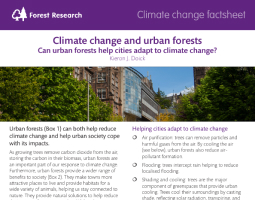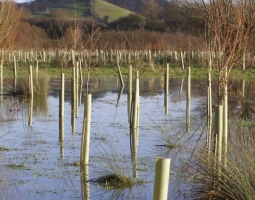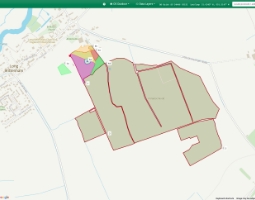Urban Forests
Management of urban forests for climate change adaptation and mitigation helps to ensure the continuing presence of trees in urban landscapes and the provision of the many benefits they provide.
Around 80% of people in England live in urban areas (Environment Agency, 2023). Climate change and the growth of urban populations exacerbate the environmental challenges of urban living such as elevated temperatures, air pollution, flooding, and biodiversity loss. Urban trees can help to alleviate the impacts of these challenges and are also threatened by them. Without climate-conscious planning and management trees and other green infrastructure can be lost as the built environment grows.
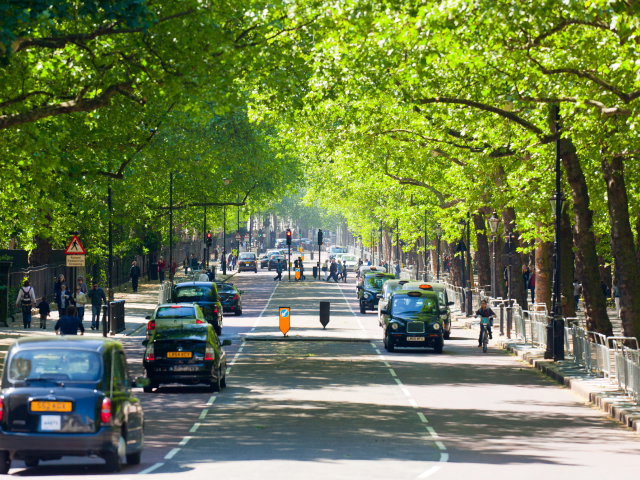
What is an urban forest?
An urban forest comprises all the trees in the urban realm – in public and private spaces, along linear routes and waterways and in amenity areas. An urban forest contributes to green infrastructure and the wider urban ecosystem, and provides many different and extensive benefits to society.
Benefits of urban forests
Urban forests provide benefits that help to reduce the effects of climate change.
Cooling by transpiration and shading
Urban trees provide cooling by both evaporation and shading. Evaporation from inside leaves (transpiration) or from precipitation held on leaves (interception) cools the surrounding air, and this effect can be felt over large areas. Shading is a localised effect and is important along streets, in parks, and for buildings.
Reduction of river and surface flooding
Trees planted on floodplains and in river catchments can help to decrease river flooding by slowing the rate of runoff and allowing more time for rain infiltration into the ground. Trees planted in soft and hard landscapes in urban areas help to reduce surface flooding by similarly intercepting rainfall and increasing infiltration.
Biodiversity
Urban trees provide rich habitats for microbes, plants, and animals. Urban woodland can create links between scattered wooded areas in the wider landscape.
Reduction of air pollution
Trees can help to encourage active travel such as walking and cycling, reducing the emission of air pollutants. They also affect how air pollution disperses, reducing air flow and trapping pollutants in some situations, and reducing exposure to pollutants in others. Trees absorb air pollutants on their surfaces and through their leaves, contributing to other measures to reduce air pollution.
Carbon storage and sequestration
As urban trees grow they sequester carbon (remove carbon from the atmosphere). Urban trees and the soils they grow in also contribute to the carbon stocks of the urban ecosystem. However, the magnitude of carbon sequestration by trees within an urban area is typically small relative to emissions from urban fossil fuel combustion.
Key considerations for urban forest management in a changing climate
Urban forests are fragmented, have multiple owners and stakeholders, have many meanings and purposes for different people, and are subject to a wide range of pressures. Establishing and maintaining a resilient urban forest happens only with effective planning, management, and cooperation.
1. Planning for resilience
Maintaining a healthy and diverse urban forest is critical to sustaining delivery of its benefits and requires a good understanding of the urban forest resource, including tree species and age composition, their suitability for their locations, their spatial distribution, and their health.
The diversity and impact of pests and diseases will increase as our climate changes.
Key considerations are:
- Which urban tree species are already suffering from pests and diseases and should be avoided as new planting?
- Which pests and diseases present in the UK or on the continent will have a greater impact in the future climate? What trees should we avoid planting or plant only in small numbers as a result?
Actions to take:
- Undertake an area-wide, sample-based survey or use inventory records to understand the species, age, and condition of the tree population.
- Have a tree and woodland strategy with clear emphasis on climate change adaptation and mitigation and which is supported by all sections of local government.
- Review the strategy regularly and use evidence to inform changes to policy when necessary.
- Engage with, consult, and co-design with stakeholders in design and decision-making about the urban forest, to discover what is important to people and to incorporate their needs and preferences where possible.
- Demonstrate the economic benefits of trees in urban areas, using an ecosystem service valuation tool such as i-Tree Eco, or an amenity valuation tool such as CAVAT.
- Plan for the replacement of existing tree species that are suffering from pests and diseases.
2. Site selection
The selection of a planting site determines what attributes a tree must have. It also has a direct impact on which benefits and the quantity of benefits the tree provides. Careful site selection is important to ensure that trees are in the right place for all users of the space.
Important considerations in site selection are:
- Is the site likely to experience waterlogging?
- Is the site prone to drought?
- What maximum and minimum temperatures are expected at the site? Is it a frost hollow or a sun trap?
- Is the soil of a shrinkable clay type, and is the site close enough to buildings on shallow foundations to pose a subsidence risk?
- Do nearby buildings create wind tunnel conditions, or is the site exposed to strong winds?
Actions to take:
- Use UK climate projections and the Climate Matching Tool to estimate what the local future climate will be, and, where practical, to inform choice of species and provenance (also see species and stature selection below).
- Work with residents, gardeners, business owners, managers of parks and woodland, developers, highways engineers, utilities providers, landscape architects and planning departments to increase canopy cover and tree population diversity, and to help ensure the longevity of planted trees.
- Select a tree and a site which will provide important and multiple benefits and will help to reduce the impacts of climate change.
- Where possible incorporate Sustainable Drainage Systems (SuDS) to help combat the effects of drier, warmer summers and more frequent and more intense heavy rainfall events.
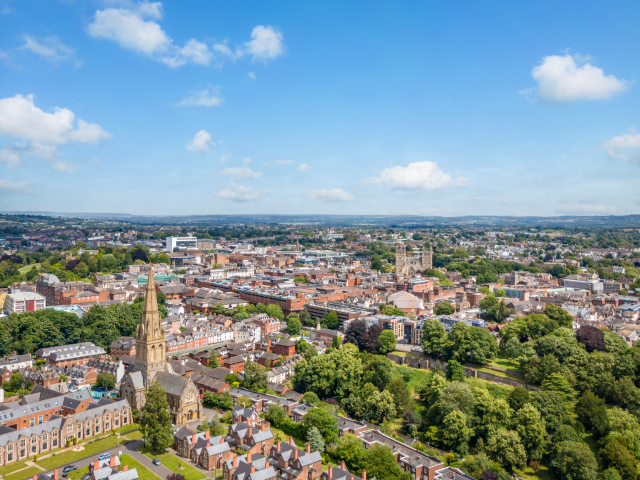
3. Species and stature selection
A diverse urban forest can be more resilient to the impacts of climate change. Historical planting has resulted in avenues or lines of trees of the same species and often of the same cultivar, and dominance of urban forests by a few species. These tree populations are thought to be particularly at risk to pests and diseases.
Over recent decades there has been a tendency to plant small stature trees, especially along streets and in new developments, because these trees require less rooting volume and less crown size management. However, small stature trees provide a lower level of benefits than large trees.
Important considerations for tree species selection are:
- Strategic diversification of species is important to help reduce risks and ensure the continuing presence of urban trees under the changing climate.
- The suitability of both native and non-native tree species for urban areas is changing as our climate changes. Water use, waterlogging tolerance, winter dormancy requirement, and heat and drought resistance should be considered when choosing native and non-native species for urban planting. It is also important to consider the geographical origin, or provenance, of the tree seed or stock, which can determine a tree’s suitability for climatic conditions.
- Consideration must be given to diversification of tree statures in an urban area to maximise the benefits that can be provided.
Actions to take:
- Consult the Trees and Design Action Group Species Selection Guide to choose trees suitable for our current and future climate.
- Consider the use of novel non-native tree species in urban areas, and work with nurseries to ensure their supply.
- Where possible, make space for large stature trees in the urban landscape, using engineered solutions when necessary.
4. Ecosystem services, disservices, and biodiversity
Ecosystem disservices are the negative effects of nature on human wellbeing. Disservices from urban trees include unwanted leaf litter that must be cleaned from streets and buildings, damage to structures by roots or drying of shrinkable clay soils, and blocking of light or views.
Important considerations for ecosystem services and disservices are:
- What benefits should be prioritised in different urban areas?
- Where will a tree provide those benefits?
- What spatial arrangements of trees will provide the range of benefits required?
Actions to take:
- Retain large, mature trees to ensure continued provision of their numerous benefits. Use tree health care approaches such as soil decompaction and rooting environment restoration for trees in decline rather than removing them.
- Choose planting sites where trees will deliver prioritised benefits.
- Use the Environment Agency flood risk map to find urban areas at risk of surface, river, and sea flooding. Plan appropriate tree planting in these areas.
- Use the GI4RAQ platform to investigate the impacts of vegetation on exposure to roadside air pollution.
- Design tree-lined routes to encourage active travel.
- Plant trees to provide cooling for vulnerable communities, in temperature hot spots, in parks, along paths and streets, around parking places and near buildings.
- Use new planting to enhance connectivity between fragmented landscapes such as woodlands.
- Plan for a range of tree statures, ages, and spatial arrangements to benefit wildlife populations.
- Consider the re-use of brownfield sites (previously used land) for tree planting, greenspace or mixed land-use. Refer to best practice guidance for land regeneration.
- Trees with the highest water use provide the most cooling through transpiration but also pose the greatest risk to building foundations on shrinkable clay soils. Assess the likelihood of shrinkable clay soils in an urban area and choose both planting site and species accordingly.
- Interaction of air pollution with pollen may result in more intense hayfever symptoms. Refer to the TDAG Species Selection Guide to avoid species with high allergy-causing potential.
5. Tree retention and removal
Urban trees may need to be removed for various reasons, such as causing damage to buildings, making space for development, or because they are in poor condition. Climate change will increase mortality in some urban tree species. Successfully replacing trees requires funding, time, space, careful species selection, and good establishment practices.
Actions to take:
- Have a tree and woodland strategy or policy that prioritises retention of large, mature trees.
- Include in the strategy the requirement to replace the benefits that are lost when trees are removed, using a benefits’ calculator.
- Retain trees, or remove as few as possible, by integrating existing trees into new developments.
6. Tree establishment
Provision of benefits by newly-planted trees depends on their survival and good growth. There is also a financial and carbon cost associated with growing, transporting, and planting trees, and if establishment is not achieved that expenditure is wasted. More frequent droughts and hotter summers make watering and mulching particularly important in the years after planting.
Actions to take:
- Specify and select high-quality nursery stock, and do not accept poor quality trees.
- Evidence suggests that younger trees establish more quickly than older trees. Consider using younger trees for new planting in all landscape types.
- Address soil compaction and where appropriate use soil amendments to improve the rooting environment. Ensure there is sufficient rooting volume provided for the tree when it reaches maturity.
- Follow best arboricultural practice for tree establishment including watering, mulching, anchoring or staking.
- Where appropriate engage citizens in the watering and monitoring of newly-planted trees.
- Monitor the health of newly-planted trees. Use data to determine what establishment practices are most effective in the local area.
- Hold contractors to account for tree establishment on development sites. Make regular site visits during and after planting. Specify establishment rather than planting targets.


